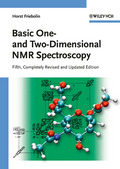Basic One- and Two-Dimensional NMR Spectroscopy

5. Auflage Oktober 2010
XXIV, 418 Seiten, Softcover
146 Abbildungen
49 Tabellen
Lehrbuch
Kurzbeschreibung
This classic textbook is a must for all students and lecturers in chemistry, biochemistry, pharmacy, and life sciences, as well as for spectroscopists. Using a minimum of mathematics, it provides the basis for understanding NMR and the interpretation of the spectra.
This is the fifth edition of the highly successful, classic textbook for bachelor and master courses, with over 20 % new material and the contents completely revised and updated.
Using a minimum of mathematics, it explains the underlying theory of this most important spectroscopic technique in a thorough, yet readily understandable way, covering instrumentation and interpretation of the spectra. It presents all students need to know about 1D, 2D-NMR, solid state and dynamic NMR spectroscopy, as well as NMR imaging, all illustrated by examples for maximum clarity. All the sections include sub-chapters that focus on applications taken from organic, macromolecular, polymer and biochemistry.
A must for students and lecturers in chemistry, biochemistry, pharmacy, and life sciences, as well as for spectroscopists.
The Chemical Shift
Indirect Spin-Spin Coupling
Spectrum Analysis and Calculations
Double Resonance Experiments
Assignment of 1H and 13C Signals
Relaxation
One-Dimensional NMR Experiments using Complex Pulse Sequences
Two-Dimensional NMR Spectroscopy
The Nuclear Overhauser Effect
Dynamic NMR Spectroscopy (DNMR)
Shift Reagents
Macromolecules
NMR Spectroscopy in Biochemistry and Medicine
"This book is a pleasure to read and if it does not arouse the student's interest, then it is difficult to see what could. It is clearly written and illustrated ... good value and essential reading for anyone wanting to know more about NMR."
Chemistry in Britain
"Another paperback that I would advise students to buy ... [it] can be recommended for general purchase by all chemists."
New Scientist
"This book deserves much praise. If only all authors took as much trouble to produce a work of such clarity and relevance... The book forms an excellent bridge between the very simple texts on spectral interpretation and more specialist works with an emphasis on mathematical theory... This book is highly educational and will be of benefit to those who have to teach NMR and to students and scientists in academic and industrial laboratories... this work is right up to date with an inclusion of most widely used modern NMR methods with a style and content that is superb."
NMR in Biomedicine
"... with it's fourth edition, Friebolin's NMR textbook remains the valuable companion and helpful guide as which it is well-known and appreciated among chemists and other scientists who seek a practical, comprehensive, but easy-to-read introduction into high-resolution NMR spectroscopy on organic molecules."
Dr. Ingo Schnell, Max-Planck-Institute for
Polymer Research, Mainz, ChemPhysChem
"The book is also especially recommended to biochemists, medicinal chemists, and others with still different backgrounds and who maybe not look back on a comprehensive training in physical chemistry but nevertheless like to understand (!) NMR in addition to merely employing it as a 'black box technique' ... What more could be said on behalf of this nice volume that has not been said before - either here or in other comments on previous editions? The best testimony is doubtless given by the book itself: go and read and be convinced by what it has to tell you. Good, clean peaks to all!"
Synthesis


